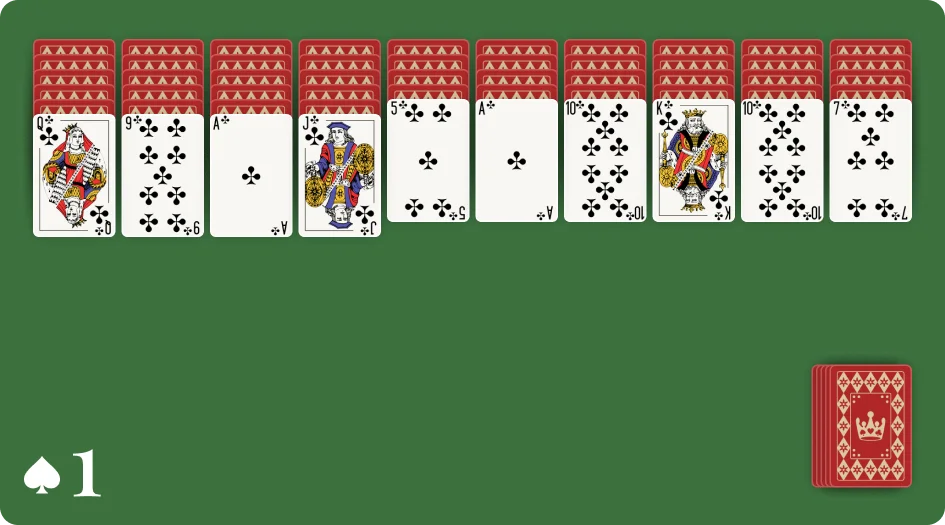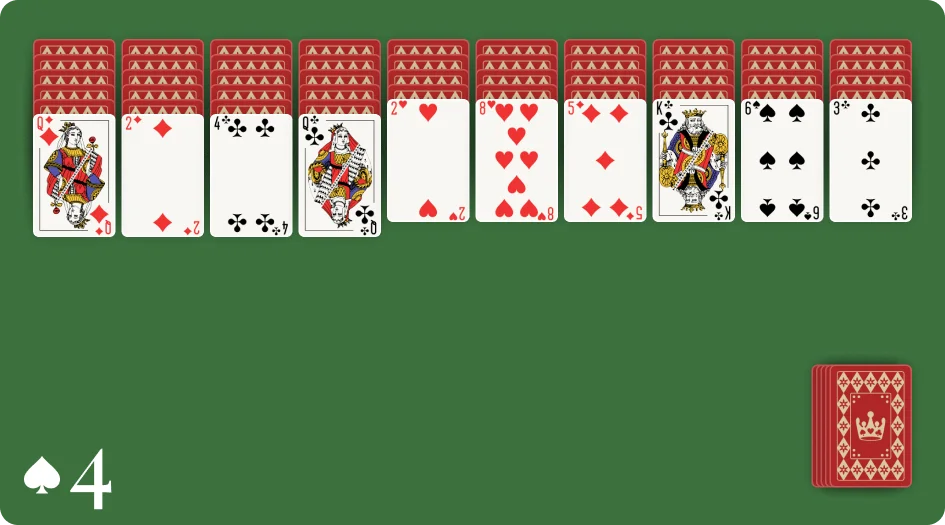I’ve discussed Spider Solitaire in several of these blogs. I’ve spoken about the different variants and how the Spider niche probably has some of the most difficult variants in the card game world. Now it’s time to address what is arguably the most difficult challenge there is: 4 Suits Spider Solitaire.
If you’ve been following thesolitaire.com for long enough, then you’ve probably noticed me alluding to this topic before. This time, I intend to transform all of you into 4 Suits Spider Solitaire maestros by sharing some of the most effective strategies I have learned.
Understanding the Game: From Basics to Multi-Suit Solitaire
If you’re like me and enjoy the progressive challenge of Solitaire, then mastering 4 Suits Spider Solitaire might be on your bucket list. So, let’s dive into the intricacies of this variant.
At heart, the game is about sorting cards into ordered sequences, but with a twist. It requires more than just blind moves to win. Your goal is to build descending sequences from King to Ace in the tableau columns. Once a full sequence is properly ordered, you can move it to the completed pile.
The best way to warm up to 4 Suits and its strategies is to understand the basics. So, let’s first look at the 1 Suit version.
Basic Strategy from 1 Suit Spider Solitaire

With 1 Suit Spider Solitaire, things are pretty straightforward since you’re only dealing with one suit. This makes it easier to form sequences. You can move groups of cards together as long as they are in descending order, which simplifies planning your next moves. It’s the perfect training ground to learn the core mechanics without overwhelming you with complexity. Here, the focus is on revealing hidden cards and creating empty spaces, which are your lifelines. This allows you to rearrange the tableau to your advantage.
Adapting to 4 Suits Solitaire
Now, let’s talk about the leap to 4 Suits. Imagine the same puzzle. But, this time, each piece can only connect with a matching suit. That’s what 4 Suits Spider Solitaire brings to the table. With all four suits in play, you need to be more decisive in your moves.
The cards can only stack in sequence if they belong to the same suit. So, the game demands a much greater focus. In multi-suit Spider Solitaire, your strategy must be flexible. You’ll often have to build temporary sequences as stepping stones.
Your mindset plays a crucial role in the switch from single to multiple suits. In 4 Suits, it’s not just about which moves you can make, but also about setting up your game for future moves.
Pre-Game Strategies
When talking about strategies, you can’t ignore the pre-game aspects. In fact, a successful game of 4 Suits Spider Solitaire starts before you even deal the cards (or open the app). Preparation is key, and starting with a strategy in mind sets the foundation for the moves you will make.
When you’re mentally prepping for a game of 4 Suits, you should keep a few essential aspects in mind. To mentally prepare for a session, try the following tricks:
- Clear the deck: Ensure a distraction-free environment to maintain focus. If you’re playing online, make sure that nothing is drawing your attention away from the game.
- Positive outlook: Adopt a positive mindset; view each game as a new opportunity. Not every game is solvable, but every game can be a learning opportunity.
- Patience is key: Remember that patience is more than a virtue in Spider Solitaire – it’s a strategy. Rushing to make moves will often result in roadblocks later on.
In-Game Tactics For 4 Suits Spider Solitaire

After the pre-game ‘warm up’, all that’s left is to make sure you implement the right strategies. The challenge is, however, that there are quite a lot of things to consider. I’ve found it useful to list these strategies and try to focus on them one game at a time.
| Strategy aspect | Details |
| Uncovering cards | Focus on revealing hidden cards to increase playable options and prevent dead-ends. |
| Tableau management | Create and strategically maintain empty tableau columns for greater maneuverability and flexibility when moving sequences. |
| Suit strategy | Try to build sequences with the same suit to avoid complications and deadlocks later in the game. |
| Multi-suit balance | Manage all suits evenly to prevent over-committing to one suit, which can limit future moves. |
| Intermediate stacks | Utilize mixed-suit stacks as a temporary measure (but with the goal of eventually sorting them into single-suit sequences). |
| Filling empty slots | Resist the urge to fill empty tableau slots immediately. Wait for the most strategic card to maintain flexibility. |
| Isolated cards | Plan ways to integrate isolated cards into sequences early. This helps avoid them becoming obstacles later on. |
| Forward thinking | Consider the impact of each move on future options. Prioritize actions that open up the board and provide more opportunities. |
| Adaptability | Regularly reassess the state of the game. Be willing to adjust your strategy based on the current setup and remaining cards. |
You can focus on isolating cards in the first few games. Once you feel as if you’ve mastered this aspect, move on to balancing multiple suits or uncovering cards. Slowly but surely, you’ll reach a point where you can effectively implement all these strategies.
Closing Remarks
I’d like to close by stressing that you won’t become a 4 Suits Spider master in a day. It’s a long journey, but you’re guaranteed to make progress if you practice and follow the tips I’ve outlined here. Don’t be deterred by the obstacles in your way and you’ll reach your goal!






